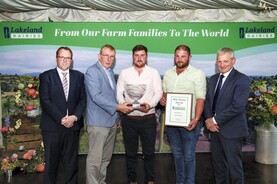What does it mean to be a ‘good farmer’? Different things to different people, no doubt, but it could be argued that our current definition of farmers may be both too narrow and too negative.
A few years ago, the Lithuanian-based Baltic Environmental Forum (www.bef.lt) set up the annual Good Farmer Awards, to present their version of what it means to be a good farmer. In the company of some Irish farmers, I recently visited a few of the awardee’s farms.
The average farm size across Lithuania’s 130,000 farms is 22ha – 46% of the land cover is used for arable farming, 33.5% for forestry and only 6% is grassland. Most of the farmland was collectivised and heavily exploited during Soviet times, leaving a challenging legacy of impoverished soils and contested ownership. However, none of this – nor the severe Baltic winters – deterred one family, the Prusakovais, from quitting their city jobs to take up farming.
An interesting life
Backonys Organic Farm in southern Lithuania – not far from the capital Vilnius – is managed by Andrius and Rasa Prusakovai. The 80ha holding – which they are incrementally expanding as they reinvest profits – produces mostly vegetables, but also beef, eggs and turkeys.
Remarkably, just five years ago Andrius worked in IT and electronics and Rasa as a civil engineer (which she still pursues part-time, though intends to leave soon). Today they run a thriving organic farm with seven large growing tunnels, in a reversal of the common trend of young people quitting farming. The couple was first drawn to farming by a desire to provide good food for their three children, and were inspired by other growers. Gradually, they began selling their excess produce, initially at a farm shop, more recently at a very successful weekend food market in Vilnius. Conscience is a big driver for the couple: they want to produce food good enough to feed their own children.
So, why does Andrius like farming, I ask? “Because it’s interesting,” is his simple answer. He finds it’s a profession where you need to know a little of everything, and every day brings different tasks and new problems to solve, which he relishes compared to the predictability of his previous work. Andrius also loves that he can be with his family all the time – the children help with harvesting produce for markets, inculculating them with a respect for the land and the food produced there.
It’s also a decision that is paying off financially – the family’s income has improved. Their produce is in-demand, their reputation growing, as is demand for organic produce. Subsidies also help; they earn up to €400/ha for organic farming, plus 50-70% support to purchase machinery and erect tunnels.

Andrius with a sack full of valuable hand-collected cow manure.
Old and new
The couple’s technical skills are clearly evident on the farm – sophisticated irrigation and ventilation systems, banks of solar panels, a climate-controlled unit to grow vegetable seedlings. To minimise labour costs, they are well-equipped with tools for planting and harvesting, machines to turn compost, and several mobile chicken runs for free range eggs (expanding to meet demand). But old tech is also gainfully employed. A herd of 18 Highland cattle (chosen for their ability to withstand the cold) are outwintered in nearby paddocks on bales of haylage, the afters harrowed-in to prepare a 1.5ha area for a summer crop of pumpkins, squashes, beets and onions. Likewise, chickens are deployed to prepare tunnels before planting, adding nutrients and controlling weeds. Cow pats from the wider pastures (stocking rates are very low as the soils are quite impoverished) are sometimes collected by hand, such is their value for boosting the growth of hungrier crops.
Grass is used in all sorts of unlikely ways here. Old haylage bales are incorporated into compost lines, mechanically chopped and turned for eventual use in vegetable beds. Dried grass powder is another innovation. Following a practice which was very common hundreds of years ago when water mills proliferated, this involves the grinding (today using blades) of dried grass into a powder (thus eliminating seeds), which Andrius feeds directly to tomato plants.

Outwintered Highland cattle, and a modern harrow, are used to recycle farm nutrients.
Lessons for policy
Back in Ireland, I was interested to read about Dutch Professor Frank Vanclay’s recent visit to Teagasc’s Mellows Campus. A renowned sociologist and a creative thinker, he outlined his four evidence-based social principles to transform agricultural policy and make farming more attractive.
One principle entailed “addressing emotional, cultural, and identity aspects of farming” (while not ignoring financial incentives). It really reminded me of Andrius and Rasa, great examples of a new purpose-driven generation of farmers.
Another Vanclay principle is ‘farmer-led innovation systems’, based on the idea that “farmers are natural experimenters who construct their own knowledge”. Andrius and Rasa certainly embody this principle, as do many Irish farmers, while our EIPs in particular have proven the collective appetite among farmers to engage in projects to co-create solutions to sustainability challenges.
Other Vanclay principes which would be hard to argue against are those of ‘simplifying policy implementation’ and increasing ‘flexibility’ or freedom to farm: Amen to all that.
The upcoming report of the ‘Commission on Generational Renewal in Farming’ will hopefully reflect some of Vanclay’s principles and thus help attract a new, enthusiastic generation of farmers which society really needs – good farmers, like the wonderful Prusakovais.



What does it mean to be a ‘good farmer’? Different things to different people, no doubt, but it could be argued that our current definition of farmers may be both too narrow and too negative.
A few years ago, the Lithuanian-based Baltic Environmental Forum (www.bef.lt) set up the annual Good Farmer Awards, to present their version of what it means to be a good farmer. In the company of some Irish farmers, I recently visited a few of the awardee’s farms.
The average farm size across Lithuania’s 130,000 farms is 22ha – 46% of the land cover is used for arable farming, 33.5% for forestry and only 6% is grassland. Most of the farmland was collectivised and heavily exploited during Soviet times, leaving a challenging legacy of impoverished soils and contested ownership. However, none of this – nor the severe Baltic winters – deterred one family, the Prusakovais, from quitting their city jobs to take up farming.
An interesting life
Backonys Organic Farm in southern Lithuania – not far from the capital Vilnius – is managed by Andrius and Rasa Prusakovai. The 80ha holding – which they are incrementally expanding as they reinvest profits – produces mostly vegetables, but also beef, eggs and turkeys.
Remarkably, just five years ago Andrius worked in IT and electronics and Rasa as a civil engineer (which she still pursues part-time, though intends to leave soon). Today they run a thriving organic farm with seven large growing tunnels, in a reversal of the common trend of young people quitting farming. The couple was first drawn to farming by a desire to provide good food for their three children, and were inspired by other growers. Gradually, they began selling their excess produce, initially at a farm shop, more recently at a very successful weekend food market in Vilnius. Conscience is a big driver for the couple: they want to produce food good enough to feed their own children.
So, why does Andrius like farming, I ask? “Because it’s interesting,” is his simple answer. He finds it’s a profession where you need to know a little of everything, and every day brings different tasks and new problems to solve, which he relishes compared to the predictability of his previous work. Andrius also loves that he can be with his family all the time – the children help with harvesting produce for markets, inculculating them with a respect for the land and the food produced there.
It’s also a decision that is paying off financially – the family’s income has improved. Their produce is in-demand, their reputation growing, as is demand for organic produce. Subsidies also help; they earn up to €400/ha for organic farming, plus 50-70% support to purchase machinery and erect tunnels.

Andrius with a sack full of valuable hand-collected cow manure.
Old and new
The couple’s technical skills are clearly evident on the farm – sophisticated irrigation and ventilation systems, banks of solar panels, a climate-controlled unit to grow vegetable seedlings. To minimise labour costs, they are well-equipped with tools for planting and harvesting, machines to turn compost, and several mobile chicken runs for free range eggs (expanding to meet demand). But old tech is also gainfully employed. A herd of 18 Highland cattle (chosen for their ability to withstand the cold) are outwintered in nearby paddocks on bales of haylage, the afters harrowed-in to prepare a 1.5ha area for a summer crop of pumpkins, squashes, beets and onions. Likewise, chickens are deployed to prepare tunnels before planting, adding nutrients and controlling weeds. Cow pats from the wider pastures (stocking rates are very low as the soils are quite impoverished) are sometimes collected by hand, such is their value for boosting the growth of hungrier crops.
Grass is used in all sorts of unlikely ways here. Old haylage bales are incorporated into compost lines, mechanically chopped and turned for eventual use in vegetable beds. Dried grass powder is another innovation. Following a practice which was very common hundreds of years ago when water mills proliferated, this involves the grinding (today using blades) of dried grass into a powder (thus eliminating seeds), which Andrius feeds directly to tomato plants.

Outwintered Highland cattle, and a modern harrow, are used to recycle farm nutrients.
Lessons for policy
Back in Ireland, I was interested to read about Dutch Professor Frank Vanclay’s recent visit to Teagasc’s Mellows Campus. A renowned sociologist and a creative thinker, he outlined his four evidence-based social principles to transform agricultural policy and make farming more attractive.
One principle entailed “addressing emotional, cultural, and identity aspects of farming” (while not ignoring financial incentives). It really reminded me of Andrius and Rasa, great examples of a new purpose-driven generation of farmers.
Another Vanclay principle is ‘farmer-led innovation systems’, based on the idea that “farmers are natural experimenters who construct their own knowledge”. Andrius and Rasa certainly embody this principle, as do many Irish farmers, while our EIPs in particular have proven the collective appetite among farmers to engage in projects to co-create solutions to sustainability challenges.
Other Vanclay principes which would be hard to argue against are those of ‘simplifying policy implementation’ and increasing ‘flexibility’ or freedom to farm: Amen to all that.
The upcoming report of the ‘Commission on Generational Renewal in Farming’ will hopefully reflect some of Vanclay’s principles and thus help attract a new, enthusiastic generation of farmers which society really needs – good farmers, like the wonderful Prusakovais.















 This is a subscriber-only article
This is a subscriber-only article










SHARING OPTIONS: